Using View Column Properties
Whenever a new column is added to the view, Notes automatically opens the Column properties box. You can open this properties box for existing columns by double-clicking the column header in the title bar or by highlighting the header (click once) and clicking the Column properties button on the toolbar. The Column properties box for the first column in a new view is shown in Figure 6.13. New columns default to a width of 10 characters and a simple function of # in View.
Figure 6.13. The first tab of the Column properties box is the Column Info tab.
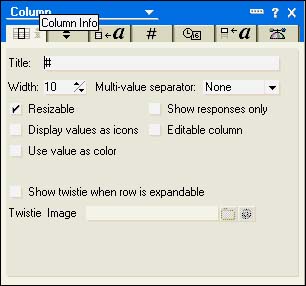
The default column definition is shown with the default width of 10 characters and a title of #. You can change the title easily by typing over the #.
Working with the Column Info Properties
The Column Info tab illustrated in Figure 6.13 has the settings listed in Table 6.4.
Table 6.4. Column Info Tab Settings
| Setting | Description |
|---|---|
| Title | Text that appears in the Column header; defaults to #. |
| Width | Width of the column; defaults to 10. |
| Multivalue Separator | The type of separator for multivalue columns. The default is None; other choices are Space, Comma, Semicolon, and New Line. |
| Resizable | Allows the user to change the width of the column. |
| Show Responses Only | Used to show response and response-to-response documents. |
| Display Values as Icon | Displays icons instead of column values. |
| Editable Column | Used in conjunction with the view property, Allow Customization enables the editing of the column from the view. |
| Use Value as Color | Programmatically controls the background and the text color of the column. |
| Show Twistie When Row | Displays a small triangle for sorted, categorized rows that are expandable. |
| Is Expandable | Clicking the twistie alternately expands and collapses the category. |
| Twistie Image | If Show Twistie is selected, you can choose another image as an alternative to the cyan triangle. |
A multivalue separator controls the display of columns that store lists. Those lists can originate from a single field, as the result of combining fields, or as the result of a formula. It is sometimes useful to combine multiline rows with a multivalue field and use New Line as a separator. This stacks the list in the column. Because the number of lines per row is limited to nine, you might be unable to display all the items in the field, but it is still a valuable technique. I often use a document to store lists that are used in multiple keyword fields on multiple forms. I use this technique to display the list fields of the document in the view.
There can be only one Show Responses Only column in a view. This is used to display information in response documents. If you need to show more than a single field, you'll have to combine the fields in a formula. When you do this, the values must evaluate to the same data type (that is, string, numeric, or time). You should also make sure that the view property Show Response Documents in a Hierarchy is selected. This combination indents the Responses Only document row under the parent document row.
Displaying icons is a good technique to use; a visual cue is presented to the user and can indicate many things, such as the status of a document, the type of a document, whether there are file attachments, and so on. More than 100 icons can be displayed, as shown in Figure 6.14. To display an icon in a column, take the following steps:
- Click Display Values as Icons.
- Uncheck Resizable.
- Set the width to a value from 1 to 3.
- Set the column paragraph alignment property to center on the Font tab.
- Create a formula that evaluates to the number of the icon you want to display.
Figure 6.14. The View Icon display palette can be found in the Lotus Domino Designer 6 help database.
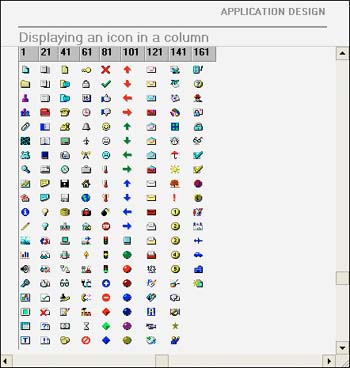
Working with the Sorting Tab
The Sorting tab enables you to determine the sort order and type of the column and to control other settings, such as clickable column headers, case-sensitive sorting, and totals. The sort options are None, Ascending, and Descending. See Figure 6.15. If either Ascending or Descending is chosen , the type can be set to Standard or Categorized. Categorizing documents in a view is a powerful display feature. Multiple categorized columns can be included in a view that can nest documents. With each category opening, other categories become available. Case-sensitive sorting sorts lowercase characters before uppercase characters. Accent -sensitive sorting sorts accented characters after unaccented characters.
Figure 6.15. The Sorting tab with the column header and secondary sort column options checked to show what's available.
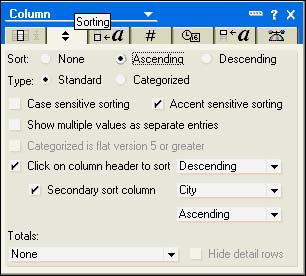
If the column contains a multivalue field, unless Show Multiple Values as Separate Entities is checked, Notes displays the entire field as a single entry.
The option Categorized Is Flat Version 5 or Greater is useful for a categorized column in a hidden view used for lookups. It provides an optimized view with the category shown on each line, so it's not pretty, but it is far faster on lookups.
Checking Click on Column Header to Sort gives the user the capability to change the sort order of a display. Four options are available from the drop-down list next to the check box: Ascending, Descending, Both, and Change to View. Of the first three options, Both is the most frequently used. For all three, clicking the column header toggles the sort order of the view. The fourth option causes an entirely different view to be displayed when the header is clicked. When Change to View is selected, a new field appears, in which you choose the name of the view from a drop-down list of available views.
When Click on Column Header to Sort is checked, another check box appears for a secondary sort column. If this check box is selected, a drop-down list of additional columns appears and another drop-down list appears for the sort order, with Ascending and Descending options.
The last item on this tab is the Totals field. There are options here for None, Total, Average Per Document, Average Per Subcategory, Percent of Parent Category, and Percent of All Documents. After a selection other than None is made, the Hide Detail Rows check box is enabled. Using this check box suppresses the display of totals for the rows (or detail) and displays only the totals for categories. One drawback when using totals is that response documents cannot be included in totals unless they are in a view that contains only response documents. This is a design limitation that is probably related to the fact that there can be no more than a single responses-only column. If you need to total values in response documents and main documents, you have to put the values into a main document or figure out a way to add the values in the response document to the parent document. The color of the totals column can be set on the Style tab of the View properties box in the Column Total text field in the Rows section.
Setting the Font Properties
The Font tab has already been discussed in earlier chapters, but in views there are two additional features, which you can see in Figure 6.16. The justification for a column can be set to left, center, or right. The standard is for text and time values to be justified left and for numbers to be justified right. A button at the bottom of the tab, labeled Apply to All, copies the font settings for the current column to all other columns.
Figure 6.16. The Font tab of a view column has two additional settings: Justification and Apply to All.
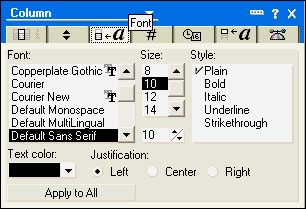
TIP
Notes defaults to a 10-point default sans serif font for view columns. If you need to pack more information into a column, you can use 8-point, which is especially useful if the view has a lot of columns. Rather than changing the font in each new column, you can create all columns with the standard font and change a single column to 8-point. When the Apply to All button is clicked, all the other columns will be changed.
CAUTION
The Apply to All button is not selective! If the column you are on has red, bold, italic, default sans serif 8-point with strikethrough for a text setting, after clicking the Apply to All button, all the other columns will be red, bold, italic, and so on.
Using the Numbers Tab and the Date and Time Format Tab
The Numbers tab and the Date and Time Format tab shown in Figures 6.176.19 have a good deal more settings in Notes and Domino 6 than in previous versions of Notes and Domino. Both tabs are fairly straightforward.
Figure 6.17. The Numbers tab controls the display of numeric values in the column.
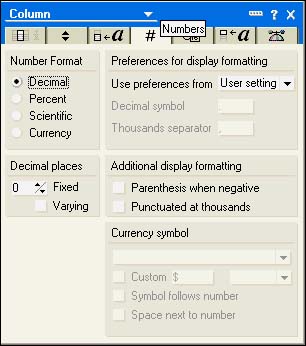
Figure 6.18. The Date and Time Format tab controls the display of time values in the column.

Figure 6.19. Choosing Custom displays more ways to customize date and time values in the column.
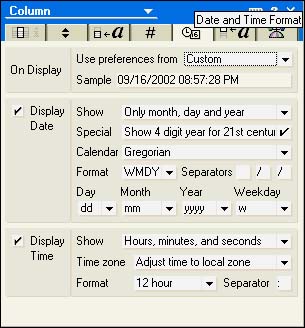
On the Numbers tab, the settings for Number Format and Additional Display Formatting were present in R5. New to Notes and Domino 6 is the Varying check box next to the Decimal spinner under Decimal Places. Also new to Notes and Domino 6 is the ability to customize the display formatting. The default setting under Preferences for Display Formatting is Use Preferences from User Setting. Notes will take the preferences from the operating system. Additionally, you can choose Custom and specify the decimal separator and the thousands separator; if you select Currency, you can then choose from preset currency symbols or enter a customized setting. This reflects the growing internationalization of Notes and Domino.
Many new features are present on the Date and Time Format tab in Notes and Domino 6. You can even specify the type of calendar from Gregorian and Hijri! Just as the selection of Custom in the Numbers tab gives you additional options, the selection of Custom on the Date and Time Format tab gives you many more options. Figure 6.18 illustrates the Date and Time Format tab with User Settings invoked, and Figure 6.19 illustrates the Date and Time Format tab with Custom invoked.
Setting the Title
The Title tab (see Figure 6.20) is similar to the Font tab for the column. The font of the column and the title are controlled independently of each other. Generally, the column and the title justification should be the same. If the column is justified right, the title should be justified right as well. Right-justified column titles often appear as though they are jammed against the next column title. To avoid this, embed a single space to the right of the title.
Figure 6.20. The Title tab has the same settings as the Font tab.
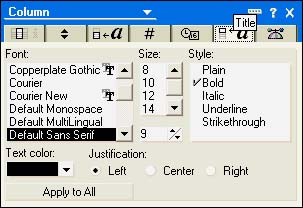
Working with the Advanced Properties
The Advanced tab (see Figure 6.21) has a field used for programmatic access. If the column contains a formula or simple action, Notes names the column internally $0 , $2 for example. If the column uses a field, the name of the field appears, as in Figure 6.21.
Figure 6.21. Because the column is using a field, the Advanced tab shows the field name (cCity).

The Hide Column check box has been moved from the Column Info tab to the Advanced tab in Notes and Domino 6. Hiding a column is useful in quite a few circumstances. For example, you might want to sort a view of personnel documents by the last name of the employee, but in the view you want to show the employee's full name, with the given name first. To do this, create a hidden column with a width of 1 that contains the field for the employee's last name. Sort this field in ascending order on the Sorting tab, and mark it as hidden. The next column can contain the employee's name with a formula of this:
cFirstName + " " + cLastName
The view presents the employee's full name but is sorted by the employee's last name. In Notes and Domino 6, you can now use a formula to hide a column, and you can also hide it in R5 or before. Using a formula to hide an object has been a part of many other design elements in Notes and Domino for some time, so this new feature is a welcome addition to Notes and Domino 6. Note that this doesn't work well for document-level conditions because the formula evaluates when a view is first opened. In other words, you can't hide a column for one document and display it for another based on, for example, the value of a Status field. But you can hide the column based on the user's name or other similar conditions above the document level.
CAUTION
Do not rely on hide-when conditions as a security measure. They might hide certain objects in forms or views, but there are other ways that the user can gain access to values in hidden objects. For information on security, see Chapter 23, "Security and Domino Applications."
The Show Values in This Column as Links check box under the heading For Web Access in Figure 6.21 removes the Release 4 restriction on having to use the first sorted column in the view as the link to the document. You can determine which view column will be used as the link to the actual document with this setting. The default is to have the first column in the view as the link to the underlying document; however, this is not always the most sensible column to use. For example, the first view column might contain an image indicating that the document is new. The second column might contain the title of the document. In this case, making the second column the link makes more sense.
Part I. Introduction to Release 6
Whats New in Release 6?
- Whats New in Release 6?
- A Brief History of Lotus Notes
- Major Features of Lotus Notes
- Types of Applications
- Whats New in Domino Designer?
- New Design Element Features
- New Language Features
The Release 6 Object Store
- The Release 6 Object Store
- Defining a Domino Database
- Understanding the Database Structure
- Creating a Database
- Working with Database Properties
- Understanding Design Templates
- Creating Your Own Templates
- Inheriting Designs from Templates
- Using Templates to Replicate Design Changes
- Using Templates as Design Libraries
- Archiving Versions with Templates
The Integrated Development Environment
- The Integrated Development Environment
- Working in the Application Design Environment
- Working with the Properties Box
- Understanding the Work Pane
- Using the Programmers Pane
- Understanding the Info List
- Understanding the Action Pane
- Customizing the Tools Menu
- Printing Source Code
- Using the HTML Editor
- Locking Design Elements
Part II. Foundations of Application Design
Forms Design
- Forms Design
- Designing Forms
- Setting Form Properties
- Working with Text Properties
- Working with Fields
- Writing Formulas in Fields
Advanced Form Design
- Advanced Form Design
- Working with Tables
- Using Graphic Objects on Forms
- Working with Form-Level Events
- Using Form Actions
- Working with Hotspots
- Understanding Sections and Section Properties
- Using Layout Regions
- Working with Special Forms
- Creating Reusable Design Objects
- Using Embedded Elements
- Using the Form Design Document
Designing Views
- Designing Views
- Defining the Elements of a View
- Creating a View
- Setting View Properties
- Creating Advanced View Selections
- Adding and Editing View Columns
- Using View Column Properties
- Adding Actions to a View
- Creating Calendar Views
- Understanding Folders
Using Shared Resources in Domino Applications
- Shared Resources
- Sharing Images Within a Database
- Creating Shared Files
- Creating Shared Applets
- Shared Code
- Creating Subforms
- Creating Shared Fields
- Creating Shared Actions
- Script Libraries
- Database Resources
Using the Page Designer
- Using the Page Designer
- Understanding Pages
- Working with the Page Properties Box
- Using the Page Designer
- Adding Layers to Your Pages
Creating Outlines
- Creating Outlines
- Creating an Outline
- Working with Outline Entries
- Embedding Outlines
- Adding an Outline to a Frameset
Adding Framesets to Domino Applications
- Adding Framesets to Domino Applications
- Creating a Frameset
- Using the Frameset Designer
- Working with Frames
- Viewing the HTML Source of Your Frameset
- Launching the Frameset
Automating Your Application with Agents
- Automating Your Application with Agents
- Working with Agents
- Creating an Agent
- Working in the Agent Builder Design Window
- Using @Commands in Agents
- Putting Your Agent to Work
- Creating a Complex Agent
- Using LotusScript in Agents
- Creating Web Agents Using Formulas and LotusScript
- Using Java in Agents
- Testing and Debugging Agents, the Agent Log, and Agent Properties
- Agent Properties via the Agent InfoBox
Part III. Programming Domino Applications
Using the Formula Language
- Using the Formula Language
- Overview of the Formula Language
- Knowing Where to Use @Functions and @Commands
- Formula Syntax
- Limitations of the Formula Language
- Working with Statements
- Using Logical @Functions
- Working with Date and Time @Functions
- Working with Strings
- Getting Session and User Information
- Working with Documents
- Retrieving Data with @DbColumn and @DbLookup
- Working with Lists
- Getting User Input
- Controlling the Flow of a Formula
- Error Handling
Real-World Examples Using the Formula Language
- Real-World Examples Using the Formula Language
- Programming Practices
- Using Formulas in Forms and Subforms
- Writing Field Formulas
- Writing View Formulas
- Using Hide When Formulas
- Working with Forms, Views, and Shared Actions
Writing LotusScript for Domino Applications
- Writing LotusScript for Domino Applications
- Software Construction
- Fundamental Elements of LotusScript
- New Technologies and LotusScript
Real-World LotusScript Examples
- Real-World LotusScript Examples
- Real-World Example 1: Importing a Delimited Text File
- Real-World Example 2: Delete a Parent Document and All Its Children: DeleteParentAndChildren
- Real-World Example 3: Schedule an Agent Robot to Refresh All the Documents in a View: Robot-DailyRefreshAllDocs
- Real-World Example 4: Return a Web User to the Place Where He Started After a Document Is Submitted: WebQuerySave-DocSubmit
Writing JavaScript for Domino Applications
- Writing JavaScript for Domino Applications
- What Is JavaScript?
- JavaScript Is Not Java
- JavaScript and the Domino IDE
- The Document Object Model
- JavaScript Support in Domino 6
- When to Use JavaScript
- A Look at JavaScript in Domino
- JavaScript Libraries in Domino
- JavaScript Principles 101
- Syntax and Command Blocks
- Statements
- Output
- Functions
- Objects
- Input Validation
- Validating Check Boxes
- Validating Radio Buttons
- Validating Selection Lists
- Calculations
- JavaScript Application
Real-World JavaScript Examples
- Real-World JavaScript Examples
- Real-World Example 1: Dynamic Drop-Down Lists on the Web
- Real-World Example 2: Dialog Boxes and window. opener on the Web
- Real-World Example 3: Dynamic Tables
- Real-World Example 4: Useful JavaScript Utilities
Writing Java for Domino Applications
- Writing Java for Domino Applications
- Introduction to Java
- Choosing a Java Solution in Domino
- Understanding the Notes Object Interface
- Writing Java Agents
- Using Other Java IDEs
- Other Uses for Java
Real-World Java Examples
Enhancing Domino Applications for the Web
- Enhancing Domino Applications for the Web
- Whats New in Designer 6
- Understanding the Domino Web Application Server
- Understanding the Basics of HTML
- Using HTML in Domino Designer
- Adding Power with Domino URLs
- Views and Forms Working Together on the Web
- Incorporating Flash into Your Web Pages
- What Its All About: XML Exposed
- How Does Domino Use XML?
Part IV. Advanced Design Topics
Accessing Data with XML
Accessing Data with DECS and DCRs
- Accessing Data with DECS and DCRs
- What Is DECS?
- The External Data Source
- DECS Administrator
- Creating the Activity
- Accessing the Application
- DECS Summary
- Data Connection Resources
- DCR Example
- Tips on External Data Access
Security and Domino Applications
- Security and Domino Applications
- How Does Domino Security Work?
- Enabling Physical Security
- Setting Server Access
- Database Access Control Lists
- The Role of the Domino Directory in Application Security
- ACL Privileges
- Enabling Database Encryption
- Using Roles
- Implementing View-Level Security
- Implementing Form-Level Security
- Implementing Document-Level Security
- Applying Field-Level Security
- Hiding the Design of Your Application
Creating Workflow Applications
- Creating Workflow Applications
- The Evolution of Groupware
- Introducing Workflow
- Creating Mail-Enabled Applications
- Using Triggers to Send Email
- Sending Mail with LotusScript
Analyzing Domino Applications
Part V. Appendices
Appendix A. HTML Reference
Appendix B. Domino URL Reference
EAN: 2147483647
Pages: 288
